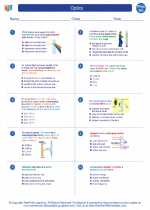Focal Length
The focal length of a lens or mirror is a measure of how strongly it converges or diverges light. It is defined as the distance from the lens or mirror to the point where parallel rays of light converge or from which they appear to diverge after being refracted or reflected. Focal length is an important parameter in optics and is used in the design and analysis of optical systems such as cameras, telescopes, and microscopes.
Types of Focal Length
Focal length can be positive, negative, or zero, depending on the type of lens or mirror:
- Positive Focal Length: A lens or mirror with a positive focal length converges light. This is typical for convex lenses and concave mirrors.
- Negative Focal Length: A lens or mirror with a negative focal length diverges light. This is typical for concave lenses and convex mirrors.
- Zero Focal Length: A lens or mirror with a zero focal length does not converge or diverge light. This is typical for a flat or planar surface.
Mathematical Representation
The mathematical representation of focal length depends on the type of lens or mirror. For a thin lens, the focal length (f) is related to the object distance (u) and the image distance (v) by the lens equation:
f = (1 / f) = (1 / v) + (1 / u)
For a concave mirror, the focal length is half the radius of curvature (R) of the mirror:
f = R / 2
Sign Convention
For lenses, the sign convention for focal length is as follows:
- Positive focal length: Converging lens (convex)
- Negative focal length: Diverging lens (concave)
For mirrors, the sign convention for focal length is as follows:
Study Guide
When studying focal length, consider the following key points:
- Understand the concept of focal length and its significance in optics.
- Learn the differences between positive, negative, and zero focal lengths.
- Be familiar with the mathematical representation of focal length for lenses and mirrors.
- Practice applying the sign convention for focal length in different optical systems.
- Explore real-world applications of focal length in devices such as cameras, telescopes, and eyeglasses.
By mastering the concept of focal length and its applications, you will gain a deeper understanding of how light behaves in optical systems and how to manipulate light for various purposes.
.


